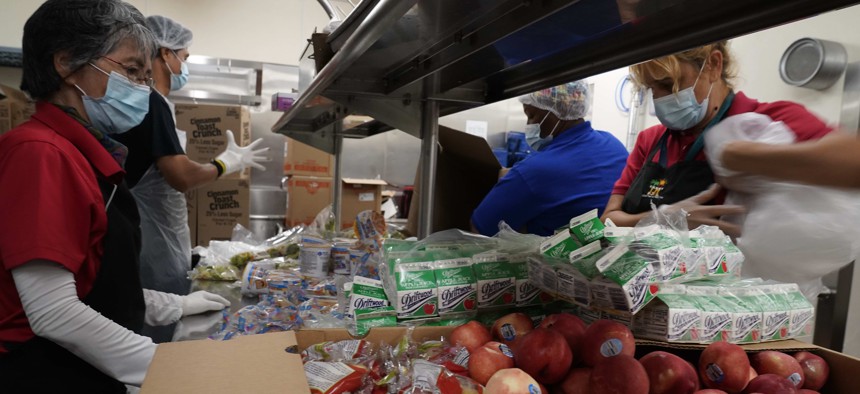USDA Offers $1.5B to Help With School Meal Supply Chain Struggles

Los Angeles Unified School District food service workers from left, Tomoko Cho, Aldrin Agrabantes, April Thomas, and Marisel Dominguez, pre-package hundreds of free school lunches in plastic bags on Thursday, July 15, 2021, at the Liechty Middle School in Los Angeles. AP Photo/Damian Dovarganes
School nutrition officials have flagged concerns about rising costs and goods shortages.
The Biden administration will provide up to $1.5 billion to states and schools to help them deal with costs driven by supply chain disruptions, Agriculture Secretary Tom Vilsack said on Friday.
School lunch operators are grappling with both goods shortages and rising costs as the nation contends with broader supply chain and inflation difficulties.
Under the newly announced initiatives, the U.S. Department of Agriculture will funnel $1 billion for schools to purchase food for their meal programs and another $300 million for food that states will distribute to schools.
The $1 billion will be distributed as cash payments known as Supply Chain Assistance funds. USDA said it anticipates that money going to as many as 100,000 schools in all 50 states.
An additional $200 million will be used for cooperative agreements to purchase local foods for schools with an emphasis on buying from historically underserved producers, USDA said.
"The food and funds USDA is distributing will help ensure schools have the resources they need to continue to serve our nation’s school children quality food they can depend on," Vilsack said in a statement.
The nonprofit School Nutrition Association cheered the Biden administration's move.
"School meal programs are paying much higher prices in the scramble to place additional orders and find new vendors when their deliveries are shorted, cancelled or delayed,” the group's President-elect Lori Adkins said in a statement.
"These new funds will help school meal programs manage higher costs, while allowing students to continue enjoying nutritious, American-grown foods in school meals," she added.
A School Nutrition Association surveyed about 1,200 school nutrition directors between October and November about supply chain issues.
Those findings, released this month, showed that top challenges school lunch programs faced—cited by over 98% of respondents—included shortages or insufficient quantities of menu items, other supplies or packaging, as well as discontinued menu items. Over three-quarters of respondents said those challenges were "significant."
A state-by-state breakdown of the federal funding can be found here.
Bill Lucia is a senior editor for Route Fifty and is based in Olympia, Washington.
NEXT STORY: The US is making plans to replace all of its lead water pipes from coast to coast






